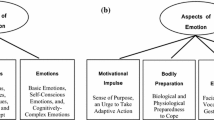Abstract
Roy F. Baumeister’s 2014 presidential address to the Society for the Study of Motivation was a call to motivation scientists to address the lack of a grand theory of motivation and to encourage them to begin working on one. This commentary addresses some of the requirements of such a theory and discusses the relatively new action–trait theory of motivation as a viable candidate for such a grand theory of motivation. Action–trait theory is based on historic “purposive psychology” and incorporates the methods of individual differences psychology. It can be represented in eight falsifiable hypotheses, three of which have already received empirical support.
Similar content being viewed by others
Notes
Purposive psychology was a teleological refinement of James’ (1890) instinct theory and is defined as “… (a) systematic exposition of psychological facts and principles which emphasizes the ends to which all actions are directed and the needs or purposes which instincts serve for the organism” (italics added, Harriman 1975, p. 157).
As a result of increased understanding of the dimensions, the theory was revised to be consistent with the evolutionary concept of trade-offs as a mechanism for shaping individual differences in the strengths of action traits (see Bernard 2012).
References
Baumeister, R. F. (2016). Toward a general theory of motivation: Problems, challenges, and the big picture. Motivation and Emotion, 40, 1–11.
Bernard, L. C. (2009). Consensual and behavioral validity of a measure of adaptive individual differences dimensions in human motivation. Motivation and Emotion, 33, 303–319.
Bernard, L. C. (2012). Evolved individual differences in human motivation. In R. Ryan (Ed.), Oxford handbook of motivation (pp. 381–407). UK: Oxford University Press.
Bernard, L. C. (2013). Relationships between individual differences in motivation and borderline personality disorder, psychopathy, and maladjustment. Psychological Reports, 113, 129–161.
Bernard, L. C. (2014). Motivation and borderline personality, psychopathy, and narcissism. Individual Differences Research, 12, 12–30.
Bernard, L. C., Cieciuch, J., Lac, A., Krupić, D., Richter, M., Silvestrini, N., et al. (2015). A cross-cultural study of purposive “traits of action”: Evidence of measurement invariance in the factor structure of scales based on a recent theory of human motivation. Manuscript submitted for publication.
Bernard, L. C., & Lac, A. (2014a). Testing a multidimensional model of putative evolved human motives. Motivation and Emotion, 38, 47–64.
Bernard, L. C., & Lac, A. (2014b). The incremental validity of motive “traits of action”: Predicting behavior longitudinally. Individual Differences Research, 12, 79–100.
Bernard, L. C., Mills, M., Swenson, L., & Walsh, R. P. (2005). An evolutionary theory of human motivation. Genetic, Social, and General Psychology Monographs, 131, 129–184.
Bernard, L. C., Mills, M., Swenson, L., & Walsh, R. P. (2008). Measuring motivation multidimensionally: Development of the Assessment of Individual Motives-Questionnaire [AIM-Q]. Assessment, 15, 16–35.
Bjorklund, D. F., & Pellegrini, A. D. (2002). Prepared to learn. In D. F. Bjorklund & A. D. Pellegrini (Eds.), The origins of human nature: Evolutionary developmental psychology (pp. 147–191). Washington, DC: American Psychological Association. doi:10.1037/10425-006.
Bothamley, J. (2002). Dictionary of theories. Canton, MI: Visible Ink Press.
Bugental, D. B. (2000). Acquisition of the algorithms of social life: A domain-based approach. Psychological Bulletin, 126, 187–219.
Buss, D. M., & Hawley, P. H. (2011). The evolution of personality and individual differences. New York, NY: Oxford.
Damasio, A. (1999). The feeling of what happens: Body and mind in the making of consciousness. San Diego, CA: Harcourt.
Damasio, A. (2001). Fundamental feelings. Nature, 781.
Dunlap, A. S., & Stephens, D. W. (2014). Experimental evolution of prepared learning. PNAS Proceedings of the National Academy of Sciences of the United States of America, 111, 11750–11755. doi:10.1073/pnas.1404176111.
Evans, D. (2002). The search hypothesis of emotion. British Journal of the Philosophy of Science, 53, 497–509.
Feynman, R. P. (n.d.) Retrieved on 19 October 2015 from https://www.youtube.com/watch?v=IaO69CF5mbY.
Harriman, P. L. (Ed.). (1975). Handbook of psychological terms. Totowa, NJ: Littlefield, Adams.
Holt, E. B. (1931). Animal drive and the learning process. Oxford, UK: Holt.
James, W. (1890). Instinct. In Psychology (Vol. 2, pp. 383–441). New York, NY: Holt.
Kenrick, D. T., Li, N. P., & Butner, J. (2003). Dynamical evolutionary psychology: Individual decision rules and emergent social norms. Psychological Review, 110, 3–28.
Kruglanski, A., Chernikova, M., & Kopetz, C. (2015). Motivation science. In R. Scott & S. Kosslyn (Eds.), Emerging trends in the social and behavioral sciences. New York: Wiley.
McAdams, D. P. (1997). A conceptual history of personality psychology. In R. Hogan, J. Johnson, & S. Briggs (Eds.), Handbook of personality psychology (pp. 3–40). San Diego, CA: Academic Press.
McAdams, D. P., & Pals, J. L. (2007). The role of theory in personality research. In R. W. Robins, R. C. Fraley, & R. F. Krueger (Eds.), Handbook of research methods in personality psychology (pp. 3–20). New York, NY: Guilford Press.
Panksepp, J. (1998). Affective neuroscience: The foundations of human and animal emotions. New York, NY: Oxford University Press.
Seligman, M. E. P. (1971). Phobias and preparedness. Behavior Therapy, 2, 307–321.
Theory. (2004). Merriam-Webster’s dictionary (11th ed., p. 1296). Springfield, MA: Merriam-Webster.
Tolman, E. C. (1932). Purposive behaviour in animals and men. London, England: Century/Random House.
Author information
Authors and Affiliations
Corresponding author
Rights and permissions
About this article
Cite this article
Bernard, L. The action–trait theory of motivation: A commentary on Roy F. Baumeister’s 2014 address to the Society for the Study of Motivation. Motiv Emot 40, 22–26 (2016). https://doi.org/10.1007/s11031-015-9537-3
Published:
Issue Date:
DOI: https://doi.org/10.1007/s11031-015-9537-3



